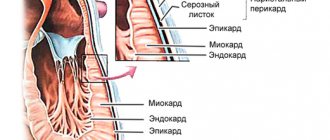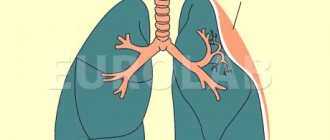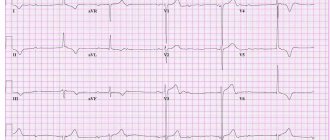Fever is a protective reaction of the human body to infection, formed during evolution. As soon as a pathogen enters our body, a dynamic change in the thermoregulatory system occurs. The result is a sharp jump in temperature to above 37 °C. Our ancestors called absolutely all diseases associated with a rise in body temperature fever. What is the status of the fever now, how to recognize it and is it possible to get rid of the symptom on your own?
What is hyperpyretic temperature
Hyperpyrexia (excessive or hyperpyretic fever) is an extremely high temperature for the human body. Body temperature with hyperpyretic fever is 41 degrees Celsius or higher. This is a critical point for our body. It is believed that with this indicator the person is in an emergency condition: he urgently requires qualified medical care.
Hyperpyretic fever is often confused with hyperthermia (overheating of the body), but there is a significant difference between these terms. In hyperpyrexia (excessive fever), critical heating of the body is caused by a primary pyrogen, a substance that increases the body's temperature. And in a state of hyperthermia (i.e. overheating), a person is under the influence of environmental factors, when isolated from which the thermometer readings will soon return to normal.
Excessive fever is a clear sign of a pathological process in the body, due to which the body is no longer capable of self-defense, and various disturbances occur in the transmission of nerve impulses.
The mechanisms of occurrence of pyretic (from 39 to 41 degrees) and hyperpyretic (41 degrees and above) temperatures are similar. However, with hyperpyretic fever, irreversible processes occur in the human body. Malfunctions in the functioning of the peripheral nervous system lead to disorders in the functioning of the central nervous system, which are life-threatening. They can cause cessation of breathing, and protein denaturation leads to the body’s temperature being out of control of the thermoregulatory centers.
Diagnostics
A patient with thermoregulation disorders is examined by a general practitioner or emergency physician (in case of critical hypothermia). The scope of diagnostic measures depends on the patient’s condition and the degree of temperature decrease. At values above 32°C, advanced laboratory and instrumental studies can be performed to identify the cause of hypothermia; at lower values, they are limited to basic methods. The most informative:
- Physical examination
. First of all, to detect the cause of a person’s low body temperature, thermometry is performed. Temperature is most often measured in the rectum; an esophageal probe is used to obtain accurate information about the internal temperature. To assess consciousness, the integrity of the pupillary and pain reflexes is checked. - Blood tests
. The basic checklist includes measuring glucose, red blood cells and hemoglobin levels. A biochemical blood test can reveal high levels of nitrogen and urea, laboratory symptoms of liver disease. To diagnose anemia, the amount of free iron, ferritin and transferrin is determined. - Hormonal profile
. To exclude pathologies of the thyroid gland, the content of thyroxine and free T3, thyroid-stimulating hormones of the pituitary gland are taken into account. You also need to examine the amount of adrenal hormones and catecholamines. To confirm Addison's disease, an ACTH stimulation test and information about the levels of essential electrolytes are required. - Electrographic methods
. An ECG is recommended for all patients, which allows detecting pathognomonic signs - Osborne wave, prolongation of the PQ and QT intervals. To assess the functional activity of the brain, an EEG is prescribed. In a hospital setting, electromyography and electroneurography of peripheral nerve trunks are sometimes performed. - X-ray imaging
. A CT scan of the brain is the first thing to do to rule out central causes of low body temperature. The images may reveal mass formations or possible swelling of the hypothalamic region. Scintigraphy of the thyroid gland with iodine isotopes helps to study the structure of the organ in more detail.
Causes of hyperpyretic temperature
In order for the temperature to exceed 41 degrees, serious reasons are needed. Common prerequisites for body heating to dangerously high levels are:
- an advanced process during acute viral infections (popular diseases characterized by hyperpyretic fever include chickenpox, hepatitis, influenza, roseola infantile, infection with rota or enterovirus);
- diseases provoked by microorganisms of bacterial origin (examples may be severe sore throat, otitis media, meningitis or pneumonia);
- poisoning with food or drinks, accompanied by an acute reaction of the digestive system and the whole body;
- heat stroke (when the patient was in the heat for a long time);
- a state of septic shock, which is a consequence of an infectious lesion of the body;
- inflammation, the source of which is localized in the peritoneum (for example, inflammation of the appendix);
- damage to soft tissues and, as a result, accumulation of pus;
- injuries to the spinal cord or brain, in which the functioning of the nervous system is disrupted or the thermoregulation centers of the body are damaged;
- severe non-food poisoning (caused by pesticides or improper use of medications);
- a consequence of the body’s reaction to someone else’s blood during transfusion;
- conducting various studies using radio waves.
Also quite common causes of hyperpyrexia are intracranial hemorrhage or the appearance of a malignant neoplasm in the brain tissue. If, under the influence of these factors, damage occurs to the brain areas responsible for thermoregulation of the body, the possibility of the appearance of hyperpyretic temperature increases.
Signs of hyperpyretic temperature
Hyperpyretic body temperature can be easily identified by placing a thermometer on the patient. However, there are several additional symptoms that often accompany high thermometer readings:
- weakness, lethargy;
- lack of coordination;
- drowsiness, apathy;
- hot dry skin;
- convulsions;
- shortness of breath;
- headache;
- disruptions in the gastrointestinal tract, manifested by nausea, vomiting, diarrhea, flatulence;
- dehydration.
Symptoms
Photo: ar.volyn.ua
Often a person does not feel a slight rise in temperature. However, when the temperature is above 38.0 °C, the clinic most often appears. There is redness of the skin (mainly the face) and increased sweating, due to which the person begins to worry about thirst. Fever may also be accompanied by a headache and a feeling of aching bones. There is an increase in breathing rate, a decrease in appetite, and confusion may occur. The person becomes lethargic, inactive, and drowsiness occurs.
In children, it is important to distinguish between “red” and “white” fevers, as there are different treatment approaches. In the first type, the child’s condition and behavior are slightly disturbed, the skin is pink, moist, hot, and the limbs are warm. This fever is more common in children and is more favorable.
The second type is characterized by a severe general condition of the child, behavior is disrupted, lethargy, moodiness, chills, pale and dry skin, acrocyanosis (bluish tint of lips and nails), increased pulse and blood pressure appear. Against this background, serious complications may appear, such as febrile convulsions and toxic encephalopathy, which require emergency medical attention.
Features of hyperpyretic fever in children
For children, hyperpyretic temperature poses a particular danger, since their body is not yet fully formed, the mechanisms of thermoregulation are imperfect, and their general immunity is weak.
Hyperpyrexia can be a symptom of many childhood pathological conditions. Therefore, you need to listen carefully to the child, and if you suspect a fever, monitor the temperature with a thermometer.
If the child has become lethargic, weak, drowsy, if there is flatulence, diarrhea or vomiting (due to weakened peristalsis at high temperatures), then this is a reason to worry.
If the temperature is high, you should immediately call an ambulance and give the child an antipyretic.
The situation becomes especially dangerous if:
- antipyretic drugs do not give results;
- the child breathes irregularly and with difficulty;
- pale skin;
- the child is delirious, sentences are incoherent (at an age when the child already speaks well);
- the body is dehydrated (this can be understood if the child cries, but the eyes remain dry, the mucous membranes in the mouth are dry, the skin is dry to the touch);
- convulsions appear.
How to reduce hyperpyretic temperature
If you suspect an excessively high fever in a patient, the first thing to do is to use a thermometer to assess the threat to health. If the mark on the thermometer is 41 degrees or higher, then the following measures should be taken:
- Call an ambulance. In this case, a patient of any age will need a qualified physician, but a special risk group is the elderly, pregnant women, and children.
- While the ambulance is on the way, or if it is not possible to call a doctor, you can help the patient in one or more of the following ways:
- give an antipyretic medicine (be especially careful when calculating the dosage, take into account the patient’s age and weight);
- place the patient horizontally, isolating him, if possible, from environmental irritants;
- If a person begins to have convulsions, then turn him on his side and ease his breathing by throwing his head back. If necessary, stick out and fix your tongue;
- if possible, ensure that the room where the patient is located has a comfortable temperature and air humidity (20 degrees Celsius, 50% humidity);
- when there is no way to stabilize the temperature, try to help the patient with thermoregulation: apply cold to places of increased blood circulation - forehead, calves, neck, wrists, armpits;
- Wipe the victim with warm water and ensure a regular supply of fresh air: as the water evaporates, it will cool the body well.
Carry out the above steps until the temperature drops by at least 2 degrees, or until an ambulance arrives.
Consequences and complications
Having a hyperpyretic temperature is dangerous for a number of reasons. The most basic of them are given below.
- If the temperature reaches and exceeds 42 degrees Celsius, then the protein in the body begins to coagulate. Protein performs many functions and plays a vital role in metabolic processes. Therefore, an indicator of 42 degrees threatens death.
- Blood viscosity increases as the body heats up. At excessively elevated temperatures, blood elements tend to stick together. Too viscous blood provokes an increase in blood pressure, since it is difficult for it to move through the vessels.
- Dehydration that occurs as a consequence of hyperpyrexia leads to disruption of water-electrolyte balance and metabolism.
- Intracellular gas exchange and the process of oxygen breakdown malfunction.
- Multiple small cell hemorrhages are observed in the patient’s internal organs.
- A patient in a state of hyperpyretic fever loses adequate perception of what is happening, his consciousness is confused, and the body is in a daze.
- There is a threat of hyperpyretic coma - a critical condition in which the patient loses consciousness and does not regain consciousness.
- In especially severe cases, swelling of vital organs, dystrophy of the heart muscle, and death of cells of the nervous system may occur.
In other articles on the website temperaturka.com you can learn about what febrile and pyretic human body temperatures are.
Treatment
Photo: prolegkie.com
Since during a rise in temperature a metabolic disorder occurs, resulting in general weakness and exhaustion of the body, bed rest is recommended. You should also pay special attention to nutrition. Food should be easily digestible and high in calories. Meals should be divided into 5-6 meals, preference is given to dishes prepared in liquid or semi-liquid form. It is recommended to limit the intake of spicy and spicy foods. Additionally, anyone with a fever should drink plenty of fluids to prevent dehydration and also to help flush toxins out of the body faster.
If the temperature rises above 38°C, antipyretic drugs are prescribed. These include non-steroidal anti-inflammatory drugs (NSAIDs). This group of drugs helps reduce temperatures and eliminate pain, and also has an anti-inflammatory effect. In order to reduce temperature, preference is given to those medications that have the most pronounced antipyretic effect. If the temperature does not reach 38°C, you should not resort to medications, since the body is able to fight such fever figures on its own without disturbing the general condition of the person.
In cases where the fever is caused by a bacterial infection, the doctor will prescribe antibiotics. Their action is aimed at eliminating the immediate cause of the disease, the symptoms of which are fever. Therefore, in the case of competent selection of an antibiotic, a decrease in temperature should occur within the first 3 days of starting to take the drug. If this does not happen, the drug was selected incorrectly, so it is necessary to replace it with one of the representatives of another group of antibiotics. In addition, to ease general well-being and speed up the process of reducing temperature, NSAIDs are used (together with antibacterial drugs).
If the increase in body temperature is caused by heatstroke, taking NSAIDs is not rational. In this case, the main goal is to cool the body to normal temperature to prevent damage to the brain and other vital organs. For this, ice packs that are placed in the armpits and popliteal fossae, a cold water bath, and cool wraps are suitable. In addition, you can spray the victim’s body with water to enhance the evaporation process, which will lead to a decrease in temperature. It is also recommended to drink plenty of fluids to normalize the water-salt balance.











